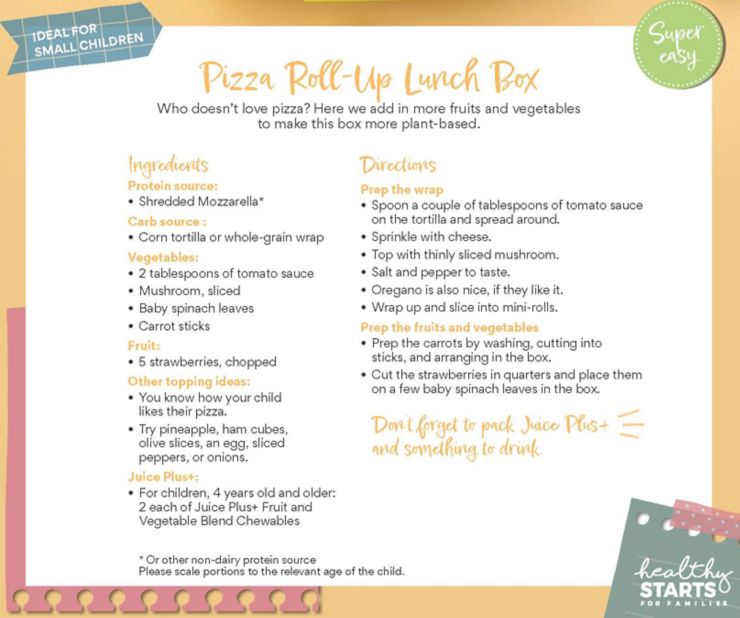How to create a plant-based lunchbox.
Eating a pIant-based diet* is beneficial for all humans and more sustainable for the planet!
Sandwiches are easy, so to make the lunch box more plant-based, I encourage you to fill half the box with sliced or chopped fresh fruits and vegetables. It’s a win-win situation.
* What is a plant-based diet?
Plant-based diets focus on eating mostly plants and finding flexibility with meat, fish, and dairy products. When compared to a vegan diet, a vegan would only eat plants and no meat, fish, dairy products, or honey. A vegetarian diet would eat mostly plants and include dairy products like cheese, milk, and yogurt. Our goal here is to start adding in more fruits, vegetables, nuts, and seeds to your child’s diet. A plant-based diet can be 100% from plants. If that is your goal, feel free to swap out the protein sources to plant-based versions like tofu, beans, peas, lentils, or nut butters.
Let’s keep it simple by planning visually for a balanced and nutritious lunchbox.
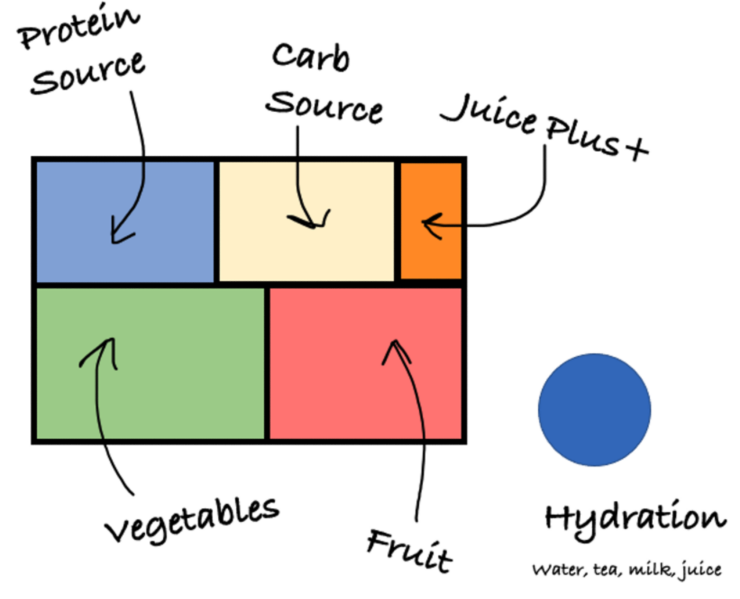
4 Food Sections**
- Source of protein
- Source of carbohydrates
- Fresh fruit
- Vegetables
Don’t forget to add in hydration plus Juice Plus+
- Water, infusions, juice or milk of your choice.
- Juice Plus+ Fruit and Vegetable Blend capsules or chewables to support your varied and balanced lunchbox.
4 Tips to make sure your plant-based lunchbox gets eaten.
Every child is unique and has their own taste and preferences. Take the pressure off by experimenting with different lunch boxes each week and ask them which fruit or vegetable they liked the best (not which ones they didn't. Keep them focused on the good).
- Pack ½ fresh – Fill half the box with chopped or sliced fresh fruits and vegetables. Kids and teens are more likely to eat these when cut up into finger food sized pieces. Smaller pieces are also easier for a younger child to swallow.
- Make it colorful – the more colors, the more enticing it will be to eat. Make it insta-worthy. Rainbows get extra points!
- Texture is important – have something crunchy, something creamy, something juicy.
- No forcing, more exploring –it takes at least 5-7 times for a child to develop the taste for something. So, don’t force them… let them taste and, eventually, they will find the fruits and vegetables they love to eat.
Food Shopping and Weekly Prep
How to make it happen?
The details on how to make food prep happen:
- Pick regular days to shop to create a routine.
- Shop when you’re not hungry, tired or, when the shops are busy.
- Buy in these colors: red, yellow, orange, green, purple, and white.
- Try something new.
- Buy already sliced if you can afford it and want to save time.
- If you have a small child, make sure to chop the fruits or veg into bite size pieces. This includes sliced grapes and cherry tomatoes in half to avoid a choking situation.
- Pealing ahead of time relieves you of the dirty work in the morning, and then you can focus on just assembling the box vs. large food prep.
- Anyone, even adults, will munch on a fruit or vegetable if it is sliced and placed in a nice container. I often do this before dinner, as an appetizer.
- These are some fruits that keep well on the shelf, in a cool place and out of the sun:
- Apples, pears, sweet potatoes, pumpkin, avocado, oranges
- These keep well in the refrigerator with a kitchen towel:
- Grapes, cherry tomatoes, carrots, celery, peppers, bananas, cherries, cucumber
Plant-based Lunchbox Chart Make your own plant-based lunchbox with these ideas!
Remember: choose one food from each section.
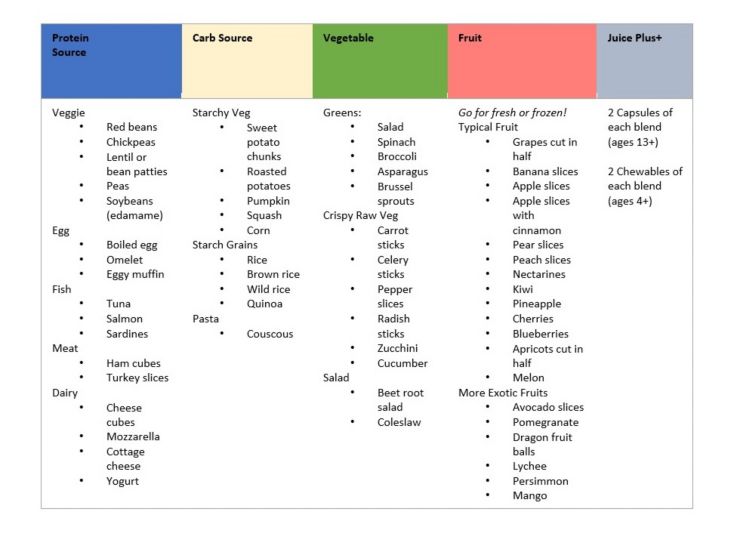
Which foods to add as a source of protein and carbs?
Most foods contain a combination of all 3 macros: protein, fats, and carbohydrates. These foods cover all basis, but some are naturally higher in protein, carb or fats than the others. We created the chart above as a general guide to help you find a variety of foods that function as a protein or a carb source.
Which fruits and vegetables pack well in a lunchbox?
Our personal favorites are:

Why add Juice Plus+ Fruit and Vegetable Blend capsules or chewables?
Juice Plus+ helps you bridge the gap between what you should eat, and what you do eat, everyday! When you add Juice Plus+ Fruit and Vegetable Blend capsule or chewable to the lunch box, it is an easy way to create routine that will stick with your children throughout their lifetime. Please enjoy Juice Plus+ as part of a healthy diet and balanced lifestyle.
Here are the recommended amounts of Juice Plus+ Chewables and Capsules for children, teens and adults.
Ages 4- 12:
- 2 Juice Plus+ Fruit Blend Chewables
- 2 Juice Plus+ Vegetable Blend Chewables = Total 4 Chewables
Ages 13+:
- 2 Juice Plus+ Fruit Blend Capsules
- 2 Juice Plus+ Vegetable Blend Capsules = Total 4 Capsules
Or
- 4 Juice Plus+ Fruit Blend Chewables
- 4 Juice Plus+ Vegetable Blend Chewables = Total 8 Chewables
Why add water, infusions, juice or milk of your choice?
Hydration is very important to a growing child, and adults as well. Most of the time we don’t drink enough. Hydration can be in the form of a drink, but can be in the form of soups, stews, or fruits and vegetables that have high-water content like pineapples, oranges, and melons.
Wrapping it all up… in a box
All in all, this was a lot of information. I hope it inspires you to start adding fresh produce to your child’s lunch boxes everyday (and maybe even your own).
Any questions? Send us a message down below or reach out to your Juice Plus+ Partner for more inspiration in nutrition.
**Please Note:
- Portion sizes can be varied to suit the age and requirements of the individual child.
- In cases of allergies or special dietary requirements, parental expertise should be used, with support from your health care professional where needed.
EASY TIME SAVING RECIPES TO INSPIRE YOU
Garden Fresh Lunch Box - Ideal for Small Children
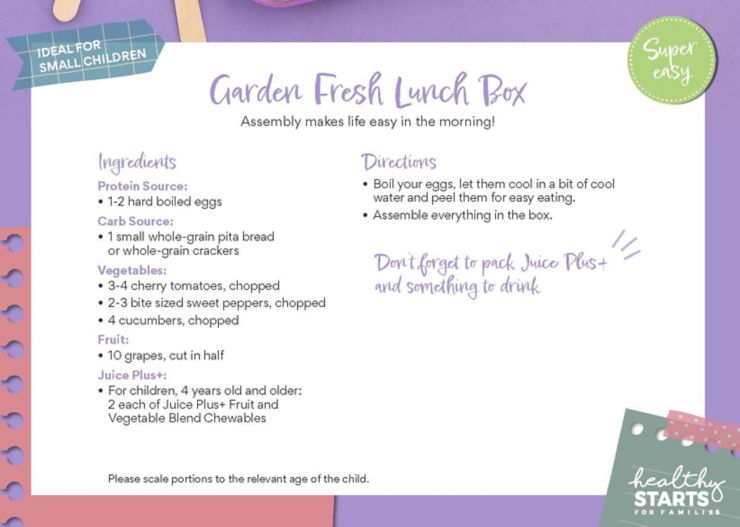
Mediterranean Lunch Box - Ideal for Teens
The flavours of the Mediterranean in a lunch box for those who want more than just a sandwich.
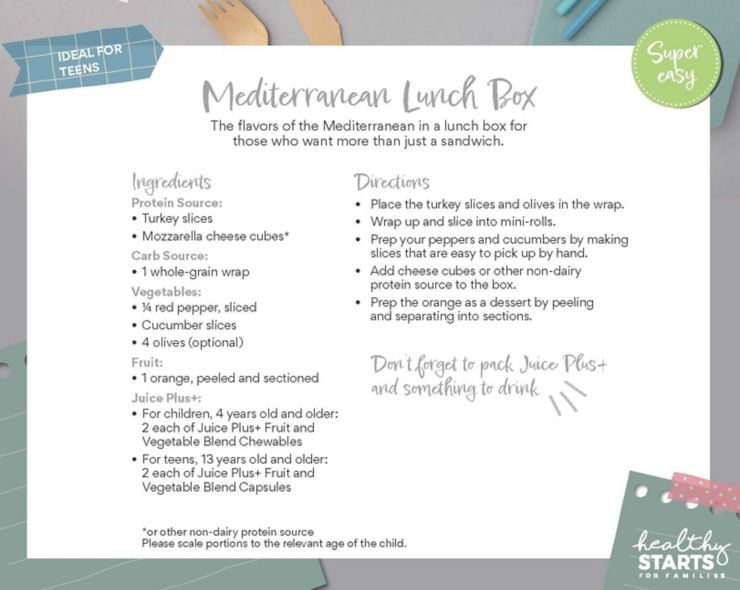
Tuna Salad Lunch Box - Ideal for teens
The easiest lunch box that takes 15 minutes to prep. Make one for yourself too, with the leftover tuna!
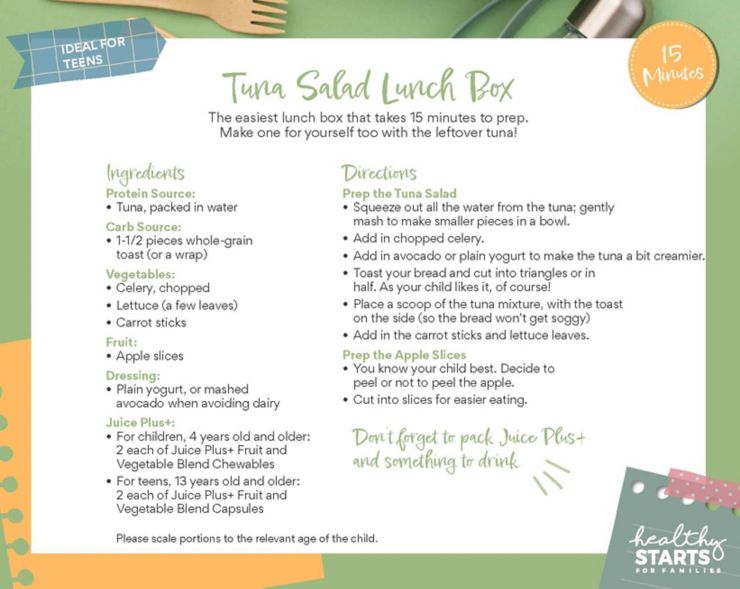
Pizza Roll-Up Lunch Box - Ideal for Small Children
Who doesn’t love pizza? Here we add in more fruits and vegetables to make this box more plant-based.
